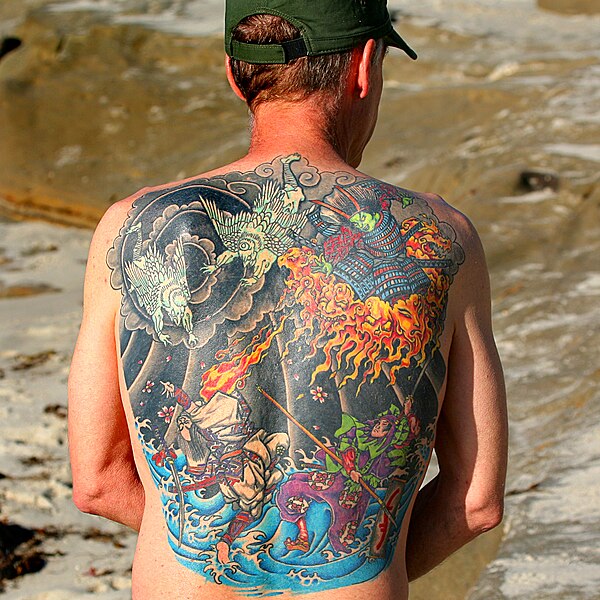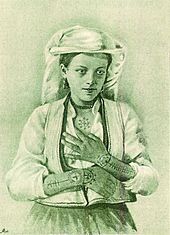
A tattoo is a form of body modification, made by inserting indelible ink into the dermis layer of the skin to change the pigment. The first written reference to the word, "tattoo" (or Samoan "Tatau") appears in the journal of Joseph Banks, the naturalist aboard Captain Cook's ship the HMS Endeavour: "I shall now mention the way they mark themselves indelibly, each of them is so marked by their humor or disposition".
The word "tattoo" was brought to Europe by the explorer James Cook, when he returned in 1771 from his first voyage to Tahiti and New Zealand. In his narrative of the voyage, he refers to an operation called "tattaw". Before this it had been described as scarring, painting, or staining.

Religious perspectives
[edit]Christianity
Historically, a decline in traditional tribal tattooing in Europe occurred with the spread of Christianity.[citation needed] However, some Christian groups, such as the Knights of St. John of Malta, sported tattoos to show their allegiance. A decline often occurred in other cultures following European efforts to convert aboriginal and indigenous people to Western religious and cultural practices that held tattooing to be a "pagan" or "heathen" activity. Within some traditional indigenous cultures, tattooing takes place within the context of a rite of passage between adolescence and adulthood. In the book of Leviticus 19:28, the Bible forbids tattoos.
There is no consistent Christian view on tattooing. The early Christian Montanist movement practiced tattooing as putting signs or seals of God's name according to Rev. 7:3; 9:4; 13:16; 14:1; 20:4; 22:4.
The majority of Christians do not take issue with the practice, while a minority uphold the Hebrew view against tattoos (see below) based on Leviticus. Tattoos of Christian symbols are common. When on pilgrimage, some Christians get a small tattoo dating the year and a small cross. This is usually done on the forearm.
There is no prohibition against tattoo within the Catholic Church, provided that the tattoo is not an image that is sacrilegious, blasphemous, or obscene. At the Catholic council of Calcuth in Northumberland in AD 786, Christians who received a tattoo "for the sake of God" (i.e., a religious tattoo in the form of a cross, a monogramme of Christ, or a saint's name or image) were commended as praiseworthy.[citation needed]
Catholic Croats of Bosnia and Herzegovina used tattooing, especially of children, for perceived protection against forced conversion to Islam during Turkish occupation of Bosnia and Herzegovina (1463-1878). This form of tattooing continued long past its original motivation. Tattooing was performed during springtime or during special religious celebrations such as the Feast of St. Joseph, and consisted mostly of Christian crosses on hands, fingers, forearms, and below the neck and on the chest.[32][33][34]
Coptic Christians who live in Egypt tattoo themselves with the symbols of Coptic crosses on their right wrists.
[edit]Islam
Tattoos are considered forbidden in Sunni Islam, but are permissible in Shia Islam. According to the book of Sunni traditions, Sahih Bukhari, "The Prophet forbade [...] mutilation (or maiming) of bodies."[35] Several Sunni Muslim scholars believe tattooing is a sin because it involves changing the creation of God (Surah 4 Verse 117-120).[36] There is, however, difference of scholarly Sunni Muslim opinion as to the reason why tattoos are forbidden.[37]
[edit]Judaism
Tattoos are forbidden in Judaism[38] based on the Torah (Leviticus 19:28): "You shall not make gashes in your flesh for the dead, or incise any marks on yourselves: I am the Lord." The prohibition is explained by contemporary rabbis as part of a general prohibition on body modification (with the exception of circumcision) that does not serve a medical purpose (such as to correct a deformity).Maimonides, a leading 12th century scholar of Jewish law and thought, explains the prohibition against tattoos as a Jewish response to paganism.
In modern times, the association of tattoos with Nazi concentration camps and the Holocaust has added another level of revulsion to the practice of tattooing, even among many otherwise fairly secular Jews.[citation needed] It is a common misconception that anyone bearing a tattoo is not permitted to be buried in a Jewish cemetery.[39]
[edit]Neopagan
Neopagans can use the process and the outcome of tattooing as an expression or representation of their beliefs.[40] Many tattooists' websites offer pagan images as examples of the kinds of artwork which they provide. At least one Wiccan Tradition uses a tattoo as a mark of Initiation, although it is an entitlement, not a requirement.
[edit]Hinduism
In Hinduism the marking of the forehead is encouraged as it enhances spiritual well-being and is one of the chakras on the body. Many Hindu women tattoo their faces with dots especially around the chin and eyes to ward off evil and enhance their beauty. The local regional tribes use tattoos to distinguish between certain clans and ethnic groups. One Hindu Goddess Lirbai mata is depicted with tattooed arms and legs. She is venerated by the Marwari and Rabari ethnic groups whose women also tattoo their bodies in this fashion. Many Hindu men and women tattoo OM on their hands or arms. This symbols protects them from evil and bad karma. In Rajastan and Gujarat, it is common to see older women with tattoos on their chests, legs, arms and hands. These tattoos are called "bindi thandole" and have religious and spiritual significance. Many of these women are completely covered in these tattoos and these designs are elaborate and intricate. Mehar ethnic groups also encourage their women to tattoo their legs and arms. Khodiyar Mata is often depicted with tattooed arms and legs. Many Hindu Gods have signs on their hands such as a swastika - these sometimes are also tattoed on hands and arms for good luck.




No comments:
Post a Comment